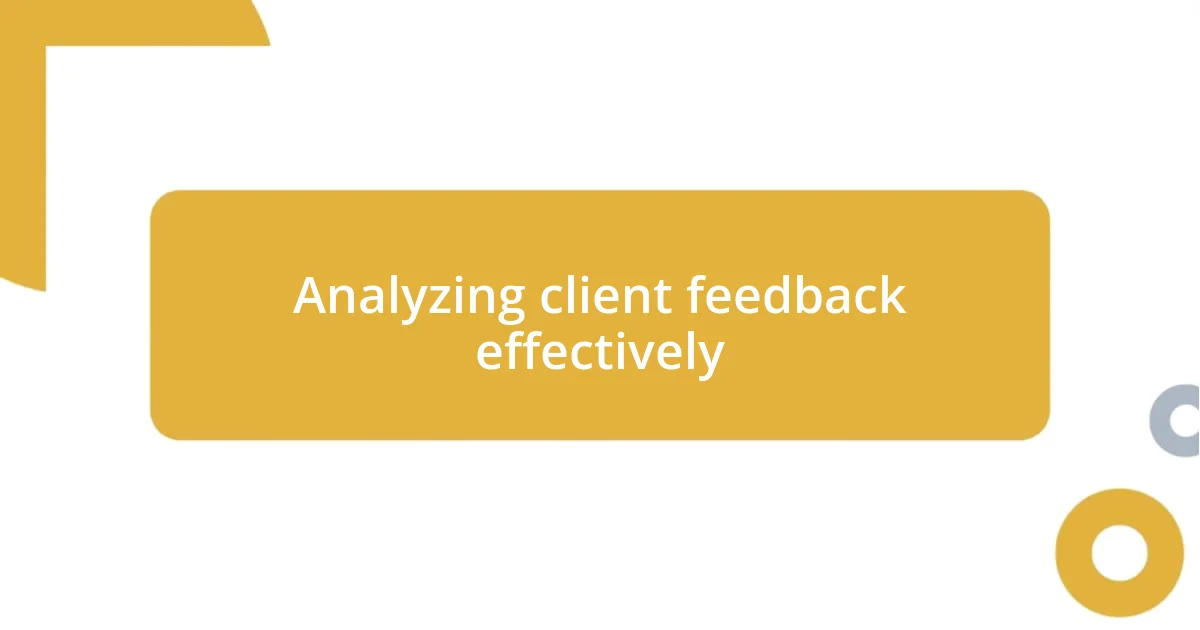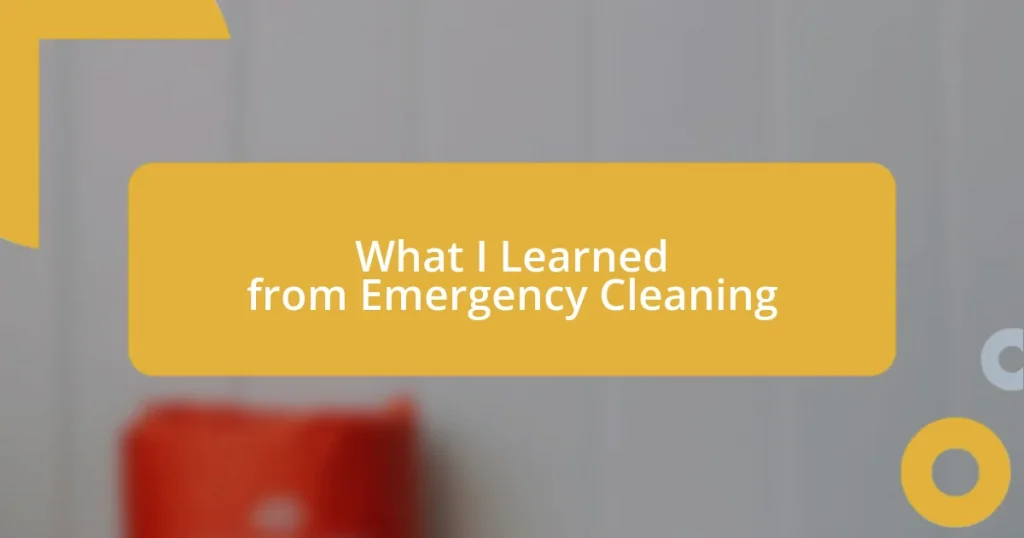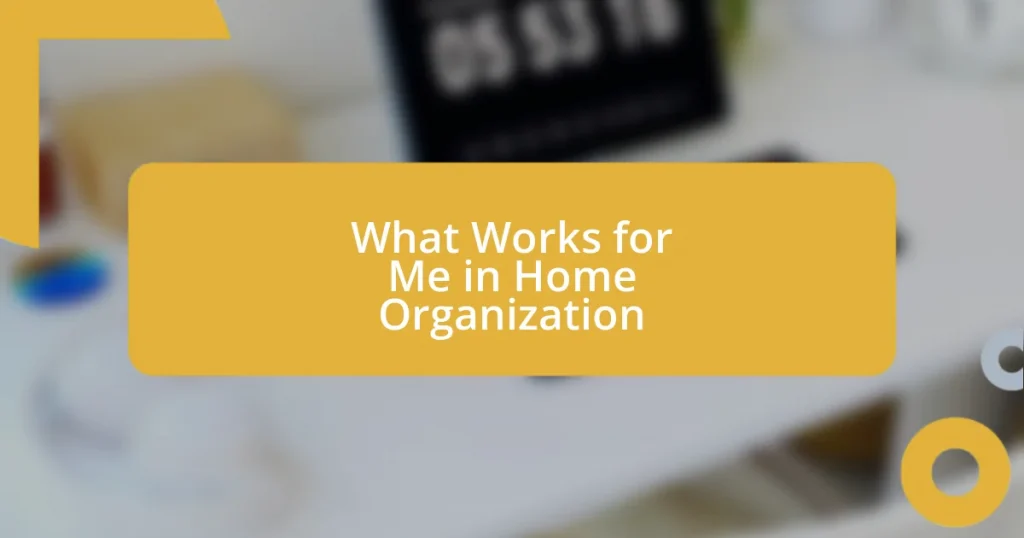Key takeaways:
- Feedback is essential for professional growth; it fosters trust, transparency, and deeper client relationships.
- There are distinct types of client feedback (unsolicited, structured, constructive criticism, praise, project-specific), each offering valuable insights for improvement.
- Implementing and measuring changes based on feedback enhances client satisfaction and encourages continuous improvement through open dialogue and patience.

Understanding the importance of feedback
Feedback is like a mirror for us in our professional journey. I remember a time when a client pointed out that my approach in a presentation felt a bit too theoretical. At first, I was taken aback, but then I realized that their perspective was a treasure trove of opportunity for growth. How often do we pause to reflect on how our work impacts others?
Understanding feedback is crucial because it’s not just about criticism; it’s a key ingredient for improvement. One client once shared that my communication style sometimes came off as too formal. This insight struck me because it made me rethink how I engage with people. If I hadn’t embraced their feedback, I would have missed out on making more genuine connections. Isn’t that what we all strive for — to connect better with our clients?
Moreover, feedback opens up a channel for trust and transparency. When a client feels comfortable voicing their thoughts, it indicates a healthy relationship. For instance, I had a client who openly discussed their concerns about our project timeline. That honesty allowed us to realign our expectations and fostered a sense of teamwork. Can you remember a time when you learned something invaluable from someone’s honest feedback? It’s these moments that really shape our professional lives.

Types of feedback from clients
When it comes to client feedback, I’ve encountered several distinct types that each provide unique insights into my work. For instance, unsolicited feedback often comes from clients who feel compelled to share their thoughts, usually rooted in their own experiences. I distinctly recall a time when a client unexpectedly praised my project timing during a casual chat. It was such a confidence boost, affirming that my efforts were recognized and valued.
On the other hand, structured feedback is something I found particularly valuable during formal reviews or surveys. This feedback is typically organized, allowing for a clearer understanding of areas for improvement. I once conducted a post-project survey and was surprised yet grateful when a client highlighted my proactive communication as a key strength. It made me realize that intentional outreach creates a smoother workflow, a strategy I’ll definitely incorporate more moving forward.
Here are some common types of feedback I’ve gleaned from my interactions with clients:
- Unsolicited Feedback: Spontaneous thoughts shared without prompting; often reveals genuine impressions.
- Structured Feedback: Organized data from surveys or reviews, highlighting strengths and weaknesses.
- Constructive Criticism: Specific suggestions for improvement; it’s all about how to do better next time.
- Praise and Recognition: Positive reinforcement that can boost morale; knowing you’re doing something right is invaluable.
- Project-Specific Feedback: Insights tied directly to a certain project, helping refine future approaches.
Each type of feedback holds significant weight, guiding me to become more attuned to my clients’ needs. It’s not just about collecting comments; it’s about understanding and implementing their suggestions in a way that fosters trust and improvement.

How to collect effective feedback
Collecting effective feedback is a nuanced process that, in my experience, requires careful thought and strategy. I’ve found that the approach I take can significantly impact the quality of the insights I receive. For instance, I often initiate conversations instead of waiting for clients to come to me. I remember a time when I simply asked a client during a catch-up call how they felt about our collaboration. Their honest feedback illuminated several strengths and areas for growth that I had never considered.
Using well-structured surveys can also yield remarkable insights. I once sent out a feedback form after a major project. The structured questions allowed clients to express their thoughts more clearly, and the responses came back with some surprises. The candid feedback helped me hone in on specific aspects of my delivery and style. It’s fascinating how a few carefully chosen questions can unlock a wealth of information about the client’s experience.
It’s equally vital to create an environment where clients feel safe sharing their thoughts. During one project, I made it a point to follow up personally with clients about their concerns. The result was overwhelmingly positive; clients appreciated the genuine approach and opened up about topics they may have otherwise hesitated to discuss. This practice not only deepened our relationship but also provided insights that transformed my future strategies.
| Method | Description |
|---|---|
| Conversational Feedback | Engaging clients in informal discussions to elicit candid responses. |
| Structured Surveys | Using targeted questions to gain clearer insights into areas of strength and improvement. |
| Follow-Up Communication | Directly reaching out to clients after projects to gather their thoughts and concerns. |

Analyzing client feedback effectively
Analyzing client feedback effectively goes beyond merely reading the words. I’ve found that taking the time to identify patterns can reveal deeper insights. For example, after receiving recurring comments about my presentation style, I decided to rework my delivery. This intentional change not only improved client interactions but also positively influenced their overall satisfaction. Isn’t it fascinating how often clients hint at what they really want, but it’s up to us to listen carefully?
One trick I’ve stumbled upon is combining quantitative data with qualitative insights. When I analyze survey results, I often cross-reference the numbers with comments to paint a fuller picture. I vividly remember a situation where client satisfaction scores were high, yet some written feedback pointed to a desire for more frequent updates. This disparity encouraged me to adjust my communication strategy, demonstrating that even high satisfaction can hide nuanced areas for improvement. Have you ever faced such a revelation?
Moreover, I genuinely believe that reflecting on feedback in a calm environment enhances the analysis process. After long days of work, I once took a weekend to thoroughly review client comments and suggestions. The quiet contemplation allowed me to distill the essential lessons from their feedback, leading to actionable strategies that I could implement immediately. I encourage others to carve out time for this practice; it can unveil insights that the hustle of daily tasks might otherwise overshadow. How might dedicating time for reflection transform your approach?

Implementing changes based on feedback
Making changes based on client feedback has often felt like stepping into a new pair of shoes—I’m excited yet a bit apprehensive. For instance, after receiving mixed opinions about my project timelines, I decided to implement a weekly update email. The moment I did, several clients expressed their gratitude, saying it made them feel involved and reassured about progress. Isn’t it incredible how a small shift can create such a significant impact in client relationships?
One memorable experience stands out when I adjusted my pricing strategy based on feedback regarding perceived value. When clients suggested they wanted more clarity on deliverables for each tier, I took that insight to heart. By redefining my offerings and clearly outlining the benefits, I noticed a boost in client engagement and inquiries. It made me realize that being open to feedback is not just about making changes but actively enhancing the overall client experience.
I can’t stress enough how important it is to follow through after implementing changes. Once, after tweaking my approach based on feedback, I reached out to clients asking them how they felt about these changes. The responses were overwhelmingly positive. Knowing they were heard and their opinions matter, anchored my belief that change is most meaningful when clients see their insights reflected in our work. Have you ever felt that sense of achievement when feedback truly reshapes your approach? It’s a rewarding cycle—listen, implement, reflect, and grow.

Measuring the impact of changes
One of the most enlightening experiences for me was when I implemented a new project management tool after hearing clients express their frustrations with tracking progress. I remember the moment they started using it— their faces lit up with relief and excitement. To measure its impact, I followed up a month later and was thrilled to learn that clients felt more in control and informed. Isn’t it amazing how the right tools can redefine a relationship?
I found that using metrics to quantify the change made a significant difference in my understanding of its effectiveness. After rolling out a feedback form tailored to assess the new system, I saw response rates double compared to older methods. This not only gave me tangible data but also reinforced my commitment to constantly improving based on client needs. How often do we rely solely on our perceptions rather than evidence?
Finally, some changes take time to show their true value. After introducing a series of client training sessions from their feedback about needing more guidance, I decided to monitor engagement over several months. At first, it was hard to see the impact, but slowly, I noticed a shift—clients became more confident and proactive. Moments like these remind me of the importance of patience in the measurement process; true change unfolds over time. Have you ever experienced a slow burn of improvement that eventually took you by surprise?

Continuous improvement through feedback
Understanding the power of client feedback is like discovering a hidden treasure that can guide continuous improvement. For me, there was a time when clients expressed concerns over the level of support they received during critical project phases. Taking that to heart, I implemented a check-in call at strategic points in the project timeline. It wasn’t just about addressing their needs; those calls turned into valuable conversations that not only reassured clients but also provided me with insights to refine my processes further. Can you imagine how much a simple conversation can reshape the way we work together?
I vividly recall another moment when clients pointed out that our communication felt one-sided. That feedback struck a chord with me. I decided to host a quarterly feedback session where clients could share their thoughts in an open forum. Listening to their voices and seeing their engagement in real time made switching to a two-way dialogue feel so much more enriching. It’s fascinating to think about how being receptive to feedback can virtually transform a relationship into a partnership.
Embracing feedback has also taught me to view challenges as opportunities for growth. When I faced pushback on my project scope due to unclear expectations, I took a step back and recalibrated my approach. By facilitating discussions around anticipated outcomes, I not only improved project alignment but also discovered new avenues to deliver value. Isn’t it inspiring how challenges can reveal fresh perspectives that ultimately enhance our approach? That realization has fueled my journey, making each piece of feedback a stepping stone toward better collaboration.















